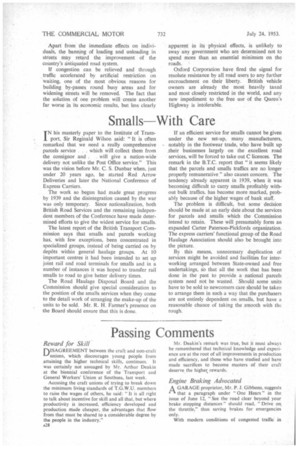Passing Comments
Page 30

Page 31

If you've noticed an error in this article please click here to report it so we can fix it.
Reward for Skill
DISAGREEMENT between the craft and non-craft
unions, which discourages young people from attaining the higher technical skills, continues, lt was certainly not assuaged by Mr. Arthur Deakin at the biennial conference of the Transport and General Workers' Union at Southsea, last week.
Accusing the craft unions of trying to break down the minimum living standards of T.G.W.U. members to raise the wages of others, he said: "It is all right to talk about incentive for skill and all that, but where productivity is increased, efficiency developed and production made cheaper, the advantages that flow from that must be shared to a considerable degree by the people in the industry."
A28 Mr. Deakins remark was true, but it must always be remembered that technical knowledge and experience are at the root of all improvements in production and efficiency, and those who have studied and have made sacrifices to become masters of their craft deserve the higher. rewards.
Engine Braking Advocated
A GARAGE proprietor, Mr. P. J. Gibbons, suggests
that a paragraph under "One Hears" in the issue of June 12, "See the road clear beyond your brake stopping distances" should read, "Drive on, the throttle," thus saving brakes for emergencies only.
With modern conditions of congested traffic in cities and towns, this advice would be most difficult to follow, for according to "The Highway Code," the overall stopping distances on dry, level surfaces are 15 ft. from 10 m.p.h., 40 ft. from 20 m.p.h. and 75 ft. from 30 m.p.h., and these are the results for emergency braking. On skiddy roads the distances might well be doubled.
With the constant stopping and starting now so often involved, and the close packing of traffic, use of the throttle only or, in other words, engine braking alone, is almost impossible. On roads with little traffic it is agreed that the principle advocated by Mr. Gibbons is the better.
Bus Washing Simplified
A N economical solution of the problem of washing
the roofs of double-deckers has been evolved by Graham's Bus Services, Ltd., for their fleet operating in the Paisley district. Previously they used long brushes, but found it difficult to avoid a streaked finish. On the other hand, their fleet was not large enough to justify the use of a mechanical washer.
To overcome the difficulty, they erected a timber platform and stairway against a garage wall to a height of about 15 ft. above the wash bed. This allows an operator to stand above the roof of the bus, plying his long brush while nine jets spray the area. The lighting has been arranged in such a way as to give the maximum help. The system has been found simple, economical and efficient, whilst the labour involved has been reduced, as the worker is operating downwards instead of upwards.
"Bobbing Up and Down . . .
A N unusual method of releasing a vehicle wedged 1-k beneath a bridge was demonstrated in Devons Road, Bow, London, one day last week. After an unsuccessful attempt to free a furniture van by letting down its rear tyres, someone had the bright idea of asking passing pedestrians to climb into the back and lend a hand. Their assistance consisted of jumping up and down together, and by using the spring periodicity. in this way the driver was able to drive his vehicle clear.
A Point in Winch Design
QN the 10-ton winch, designed to fit on the Scammeil short-wheelbase motive unit of an articulated vehicle, there is a specially shaped roller over which the rope passes on its way from the rear fairlead rollers to the drum. The effect is that the resultant force of the rope on the roller is always normal to the roller surface, which removes the component of rope tension along the winch drum axis. The rope is held up to the drum at the tangent plane by a spring-loaded pressure roller.




























































































